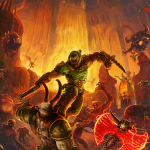A recently released Steam demo tells me psychological survival horror game Holstin is unmistakably Slavic. I’ve been waiting for this. My Bulgarian mom and her mom, my baba, raised me to be loud and pessimistic, but always protected from true gloom by the laminated Virgin Mary we remorsefully held in our wallets. From my two-and-a-half hours with Holstin, set in ‘90s Poland and made by Warsaw-based indie studio Sonka, I think the finished game will satisfy my grouchy generational craving for chaos.
The demo, videos of which got a ton of attention on Twitter, comes in two parts: an exploration of a multistory house, seemingly set mid-narrative, and a combat tutorial. The first part makes Holstin’s target atmosphere obvious, trapping you in 1992 Poland, in a small, wood-paneled home made more smothering by occasional crashes of thunder coming from outside. The house has been overtaken by a mysterious ooze—patches of tumored, flesh-pink tendrils that deplete your health if you touch them, but retreat once you turn on the lights.
Holstin offers a 3D puzzle
You, a man with deep frown lines, don’t know what’s happening. You just want to find your friend, who was in this town until he vanished. To help find him, I move lightbulbs from room to dark room to un-goo pathways, and repair breakers that can illuminate one entire area at a time. I rotate the isometric camera to find more secrets in its eight possible angles, like obscured entryways or helpful lamp locations.
This can occasionally be frustrating (like when I couldn’t click on an important item until fiddling with the camera for a good five minutes) and, for me, often nauseating—games easily make me motion sick.
But I can imagine horror game enthusiasts less prone to dizzy spells and more efficient at solving puzzles will find the camera design uniquely engaging. Sonka tells me, too, that it’s deploying some gameplay changes and bug fixes on September 18.
In the meantime, I revel in Holstin’s small details. I like the crochet square I see relaxed over a shattered TV; it reminds me of my family’s apartment near the Black Sea shore, and makes me wonder what it would be like if it were infiltrated by zombies. I notice the massive cross that hangs patiently over a doorway, and the matter-of-fact horror elements that surround it; “there’s a charred hand in a pile of ashes,” the screen says when I click on a nearby fireplace.
Is this Polish Dead Space?
The demo’s combat tutorial, which is set up like a roguelike prison, suggests Holstin will at some points break from brain-teasing to take inspiration from shooters like Dead Space and Resident Evil 4. Notes I find in this level point to an overarching story related to Nazi experiments, but I think modern Eastern Europe occasionally has a bizarre fascination with World War II, and I’ve trained myself to mostly ignore it. But if you like getting dirty, it’s there for you to dig through.
I’m, instead, thinking about Dead Space. Holstin suggests you shoot at resilient enemies’ diseased extremities to slow them down, but, in its current state, the game’s aim doesn’t easily allow for precision. Still, I admire the different enemy types, some of which slump over and turn their heads into gasoline-colored porcupine spikes, others which are essentially violent meatballs of blood. And while Holstin’s crafting elements remind me of RE4—open up your inventory to combine herbs with alcohol for health, or gunpowder and nails for bullets—its stamina bar, which overlaps with health and has a smaller regeneration pool each time I’m injured, tells me the game may be inspired by great horror, but wants to stake its own claim in the genre.
This, accompanied by peppy Polish voice acting, makes me think Holstin could be a fantastic horror game, especially for fatalistic Slavs and aspiring babushkas. It doesn’t yet have a release date, but you’ll eventually be able to play it on PC and consoles.























